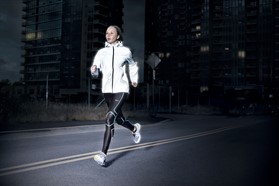How to Stay Visible in Public While Training
August 15, 2017

How to Stay Visible in Public While Training
Marathon popularity is at an all-time high. In 2014, over 541,000 different finishers of all ages, genders, sizes, and backgrounds participated in the 1100 marathons across the United States, and the record-breaking numbers only continue to grow. However, it is guaranteed that these 541,000 runners did not prepare for their marathons quickly — especially when running distance, a great deal of preparation and steady practice is required.
If you are currently training for a marathon, consider the following tips to stay safe before your next public training session.
1) Always stick to vibrantly-colored gear.
Many regular runners have a go-to set of gear and clothing that they find most comfortable. When running a marathon, the appearance of your outfit matters much less than its function, especially since marathons are sectioned off from public interference.
However, when training before a marathon, there are no barriers in place to separate you from regular life. Most runners find themselves running alongside traffic in both cities and suburban neighborhoods alike, which can make it difficult to stay seen. The most reliable and easy way to re-main noticed in these situations is by wearing bright colors. Vibrant, neon shades help you to stick out against any environment regardless of where you’re running so cars are aware of your presence. Most popular athletic wear and shoe companies carry good quality gear in these col-ors, so it is very worth the investment if you do not already have a set.
2) Pick your running time wisely.
As is probably obvious, the time of day you choose to train will drastically affect the temperature, lighting, crowding, and running areas available to you. These should all be weighed when decided what time of day is best for you to train. For instance, running during the day allows you to be more easily seen in daylight, but runs the risk of you traversing packed traffic intersections and dealing with more cars. Depending on your area, running at night can reduce this risk, but it also prevents you from notic-ing potential hazards on your running path (or prevents other cars from noticing you.)
In general, running during the day is the best way to go. However, if you choose nighttime running (or if this is the only time you have available) be sure to invest in reflective tape and a headlamp or flashlight that can be used to navigate in the dark.
3) Plan your route ahead of time.
Marathons plan your entire route for you. This gives runners time to see the terrain ahead of time and plan out their running strategy before they begin. However, planning your own running course and practicing in public can be far less predictable. Whether there are sudden construc-tion sites, heavy traffic signal areas, or dangerous blind curves and driveways, there are far more factors to consider when staying safe and seen in public.
Before you try a route for the first time, try to drive the path to check for any unexpected hazards. Just like with a marathon, you can plan ahead to avoid certain potholes, or hang more to the left on a sharp curve so you can still stay in a drivers’ line of sight. While you can never prepare for every potential scenario, it is always best to play it safe beforehand and train safely for your next marathon.
comments powered by Disqus